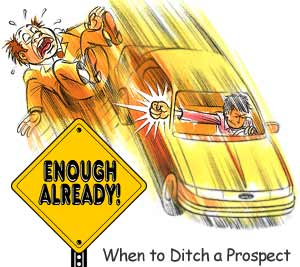 |
|
||||||||||||
|
Columns by Nancy K. Austin: Everyone's a Critic... Even You
List all of Nancy's columns
Visit our other Getting Work Columnist
|
Okay, let's say you've mowed through most of the past month chasing a red-hot prospect or two. The dance goes like this: you call, they promise the moon, then a week goes by with nary a smidge of new business. Zippo. Nada. Diddly. You persist. (As you should.) They swear they've looked at your materials, they're trying to make up their busy minds, and they'll be in touch real soon. But then another couple of weeks slink by, your calendar's in limbo, and you're still work-free. On the theory that the third time really is the charm, you make contact again, only to hear something like, "The project's been back-burnered," or "We're rethinking our budget, but hang in there, you'll be the first to know when it all shakes out!" Is there a sale lurking around this corner, or what? Should you keep at it, or throw in the towel and start working on other leads? How many unrequited calls should you be prepared to make before you pack it in -- two? Five? Twenty? How do you decide if the only thing you're chasing is your tail, and the time has come to say sayonara? The first big point to consider is what it costs to make a sale. One thing's for sure, the economics of selling can be hard to get a handle on. Since the 1970s, businesspeople of all stripes have been shamelessly batting around a certain influential statistic -- the one that says it's five times more expensive to go out and unearth new customers than it is to keep your mitts on the ones you've got. That little bomb of a finding has been detonated in every customer-retention program on the planet, and it's done a world of good by helping businesses treat their current customers as accrued assets, not afterthoughts. But the 5-to-1 rule, I'm sorry to report, has also been outrageously misconstrued as hard evidence that sales prospecting is a huge waste of time and money compared to the bottom-line benefits of coddling current clients -- a sadly mistaken assumption that can lead IPs to burn through their prospects way too fast. Quick-on-the-draw types seem to think that if attracting new clients costs five times as much as courting repeat business, they need to get a real nibble on the first sales call to justify sticking with it; otherwise, it's just too expensive to keep prowling after business that might never materialize. One shot per target is all they'll take. Well, let's get this 5-to-1 story straight, shall we? The outfit that conducted the original research, Technical Assistance Research Programs (TARP), derived the numbers from its work with a U.S. car company. The original study compared advertising costs (to attract new car buyers) with goodwill expense (to hang on to existing customers), which is where the 5-to-1 ratio came from. That's an attention-grabbing comparison in an industry where the repurchase rate is only about 30 percent, but don't leap to any hasty conclusions about what it means for building an IP business. It would be tempting -- but wrong -- to assume that the sales environment and economics of your local Ford dealer line up with yours. Believe TARP when it says now that the real ratio is a lot more capricious, ranging anywhere from 2-to-1 to 20-to-1, depending on a whole slew of factors that are, natch, hard to nail down. And so the only conclusion you can safely reach is that hooking new clients carries certain costs (your time, materials, overhead, and opportunity costs -- the alternatives you're passing up while you pursue individual prospects), and that these costs mount the longer you pursue a particular lead. If you place 20 calls, you might speak to 15 people. Half of those might ask you to call back or to send more information, and about half of that group are real prospects. Eventually, you'll come to a point of diminishing returns, and you'll need a fresh batch of possible prospects. Of course, you'd be an idiot to stop selling, promoting, and networking, but there are limits -- and you'd best discover them early, or else risk becoming a royal pain who simply won't quit, or alternatively, one who wimps out. "The key is to know when and how to follow up," says Ilise Benun, a self-promotion specialist who works with promotionally challenged IPs and small business owners. So how many contacts should you make before you call it quits? "Three is a magic number in my mind," Benun says. Sales experts and trainers all seem to hover in this territory -- three or four calls, max. "Don't go beyond three direct efforts if you're not getting any response from a prospect," Benun adds, because there's a famously fine line between persistence and pain-in-the-buttness, and we all know which side we're supposed to be on. If you offer, say, a 30-day guarantee or a small free trial order as an inducement and still get nowhere, Benun advises putting the non-responders into a follow-up system, which in her case is a carefully tended mailing list that receives updates, articles, and her quarterly newsletter. Sometimes she writes a brief newsy note on postcards, since cards are "cheap and easy," a simple way to remind people you're out there. "Remember that when you're out of sight, you're out of mind," she says. And here's the thing: it is in the mind -- your mind -- that the lovely dream of getting new work can turn into a marketing nightmare. It's what holds you back from making that second call when your first went nowhere. No doubt, it's easy to be paranoid, to imagine the reason for your client's non-response is a less-than-enthusiastic attitude about working with you: They don't want me, somebody badmouthed my work, they chose somebody else, I'll never eat lunch in this town again. All twaddle, of course, but try to explain that to a nervous IP who's just dropped everything to produce a proposal for a prospective client who simply had to have it by tomorrow morning, and now -- zip! That's exactly the sort of circumstance that produces premature quitting, because it's so seductively easy to give up right there, at the first hint of "no." Happens all the time. Happily, paranoia (everybody's out to get you) has a sunnier flip side, and it's called "pronoia," the idea that everybody's out to help you and appreciate you -- you'll feel the love, if you give in return. The term, a favorite of mine, was coined by Helena Cronin, social scientist and co-director of the Centre for Philosophy of Natural and Social Science at the London School of Economics. Play around with Cronin's idea and you, dear prospect-chaser, become the bearer of gifts, not a slick huckster with an agenda. As Ilise Benun puts it, "What if every time you make a cold call, you think of it as something a prospect wants, something that will help them move closer to their goals?" The distinction is much more than semantic, because it has the power to change behavior. When a pronoiac IP gets no response, she hears "not now," and plans a follow-up strategy so she's there when the client is ready. If, right from the start, you've communicated with your prospects in every possible way -- email, personal notes, follow-up phone calls, samples, press kits, sending along an article you thought they'd appreciate, showing your face in a real live meeting -- and you're still striking out, then give it a rest already, and don't have a cow about it. Says Benun: "Keep in mind that people get all excited about projects and things when you're right there, and then they go back to work and reality hits. You didn't do anything wrong, it's just that priorities naturally shift, and you have to work with what's real." In the real world, stuff happens and life gets in the way, by which I do not mean to suggest that you shouldn't do your darndest to find out why a seemingly hot prospect blew you off -- even if it's been months since you exchanged business cards and you'd rather eat bees than make this kind of call. "It's never too late," Benun believes. "That's the easiest cop-out in the world. Make an effort to find out what derailed the process, why it's on the back burner." That will set the stage for what your next contact should be, and it will teach you a thing or two about your approach, your timing, and how to work with a potential client. So when a prospect tells you, "I'm not ready," don't stop there. The only way to tell if you're looking at a blind alley or business bonanza is to ask when to call back. If you get the feeling that they'd agree to anything to get off the phone right this minute, ask yourself if pursuing this prospect is really worth your time and sweat. If the answer's no, let it go. If the answer's yes, give it your best. |
|
|
We'd love to hear your feedback about this column, or put you in touch with Nancy K. Austin if you like. You may also like to see her biography. |
The 1099 name and logo are trademarks of 1099 Magazine.

